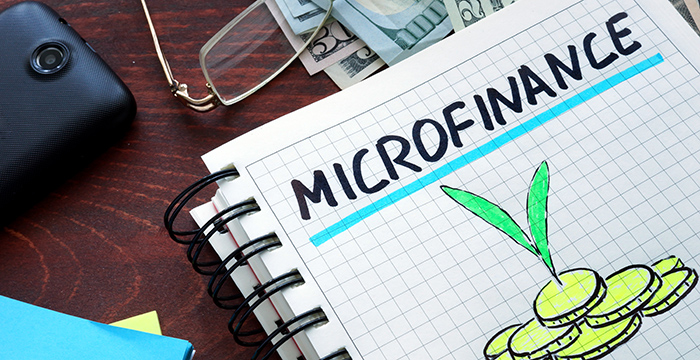
Asian Development bank defines Microfinance as the provision of a broad range of financial services such as deposits, loans, payment services, money transfers, and insurance to poor and low-income households.
In short, Microfinance is providing basic financial services such as loan, insurance etc. to poor at low costs. It helps in financial inclusion.
(Read: Financial Inclusion and Pradhan Mantri Jan Dhan Yojana)
Microcredit is a subset of micro-finance. It involves the provision of credit or loan to poor at low-interest rates. Similarly, we have micro-insurance, micro-pension etc.
We need microfinance because large numbers of poor have been excluded from the traditional banking system. The reasons are:
- High transaction costs: The screening and monitoring costs of lending a large number of small loans to poor people are high.
- High risk: Poor have no assets to offer as collateral. Hence, lending is risky.
- Moral hazard: Borrowers have less incentive to repay the loan. They have no assets that the bank can attach in case of default. It creates moral hazard.
Micro Finance Institutions (MFIs) experimented with innovative and unconventional ways to solve the above issues.
The most popular method adopted by most MFIs is group lending with joint liability. In this, members of a group are jointly liable for any loan amount extended to the group and any default could compromise their ability to raise future loans. It gives members of the group, the incentives to screen and monitor each other and see to it that the borrower repays the loan. It reduces lending costs to poor and solves the moral hazard problem.
There are some MFIs which provide individual based lending also. They reduce their lending cost by means of regular contact between borrower and Microfinance institution (relationship lending) and by making future loans dependent on regular repayments (dynamic incentives).
Microfinance has been touted as a market-based, finance-led solution to problems of poverty and development. Recognising this potential, the UN had declared 2005 to be the International Year of Microcredit.
In 2006, the founder of Grameen Bank, Muhammad Yunus received the Nobel Peace Prize and it further reinforced the credentials of MF as a tool for achieving financial inclusion and employment generation. [Muhammad Yunus is also considered as the father of microfinance]
The Nobel Committee recognised the potential of Microfinance to establish long-lasting peace by helping people break out of the vicious circle of poverty by generating their own employment.
India’s first Microfinance Institution was ‘Shri Mahila SEWA Sahkari Bank’ (SEWA) set up by Ms Ela Bhatt in the year 1972. It is a revolutionary institute that works towards financial inclusion and inclusive growth.
Though over the past few decade, NABARD’s “SHG-Bank Linkage Program” (SBLP) aimed at connecting self-help groups (SHGs) with banks has become most popular in India and has created the largest microfinance network in the world.
[Self-help group is a small association of poor people. It consists of 10-20 people. They come together for the purpose of solving common problems. It promotes small savings among its members. the savings are deposited in a bank. The microcredit model of India is based on linking these self-help groups with banks. Hence, the name SHG-Bank Linkage Program]
Some other prominent MFIs around the world are Grameen Bank and BRAC in Bangladesh, BancoSol in Bolivia, Bank Rakyat in Indonesia, SEWA in Western India and SHARE and BASIX in Southern India.
Microfinance has been recognised as the biggest social revolution of the last decade. It leads to empowerment of the vulnerable sections of the society.
Although Microfinance is supposed to be a finance-led model to alleviate poverty, the large majority of Microfinance institutions (MFIs) are not financially sustainable. Most MFIs are able to operate without covering their costs due to subsidies and gifts from Government and other donors.
Ideally, an MFI should be able to cover its costs with its revenues.
For microfinance to be sustainable there is a need for investment opportunities for borrowers that yield higher returns than the interest rates charged by the MFIs.
The biggest challenge in the success of microfinance is the simultaneous development of investment potential and improvement of skill levels of the borrowers so that they can advantage of the increased credit access.
In spite of all this, there have been definitely been significant advances in recent years and the concept and practice of SHG-based microfinance have developed deep roots in many countries.
In the last 3-4 years, the Reserve Bank of India has made substantial efforts to put in place a favourable regulatory environment for the microfinance sector. These are:
- Setting up of Microcredit special cell in RBI
- Providing complete flexibility to the financial market to formulate their own model for extending microcredit.
- Treating microfinance extended by banks as part of priority sector lending. (PSR)
- Allowed FDI in microcredit to encourage foreign participation in various microfinance projects.
- Launching of Mudra or Micro-Units development refinance agency bank to refinance the loans extended by MFIs.
All in all, Microcredit has effectively graduated from an ‘experiment’ to a widely-accepted paradigm of rural and developmental financing in India
Liked this post? Don’t forget to share.